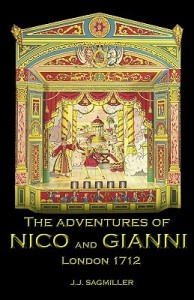 The Adventures Of Nico And Gianni: London 1712
The Adventures Of Nico And Gianni: London 1712
by J. J. Sagmiller
CreateSpace. 316 pages, $15.95 (paper)
AS IF peering through a kaleidoscope of twisted history and distorted time, I could not help but become drawn in by the characters and images that J. J. Sagmiller has created in this delightful romp through the raucous world of early 18th-century London theatre. The engaging plot is both simple and complex, containing feints within ruses, portraits within paintings, and plays within plays. The prose is simple and straightforward, relayed through the voice of Nico, a teenage castrato with a voice to charm the masses and a wit to help him and his companion, Gianni, to get by in a difficult world.
Nico and Gianni are both castrati who have sailed from their home in Naples to pursue fame and fortune in the London theatre, where Italian opera is all the rage.
Nico and Gianni thus enter into the lavish world of the London theatre, which Sagmiller has thoroughly researched. The characters are as colorful as the settings, and their names, evocative of their personalities in accord with traditional farce, imply that this satire stays true to the traditions of Italian comic opera that it portrays. The Italian cast of characters includes maestro Signor Cantabile and the heady and indignant “diva,” Mr. Indegno, along with the two protagonists, now named Nico Premeroso and Gianni Frivolo. The English characters include the male prostitute Peter Penetrable, the villainous Mr. Filch, the amiable matrons Mrs. Busybody and Lady Sweetbury, and the handsome Herbert Heartsease. While the trope of naming may seem trite, it recalls the classic theatre tradition in which characters are exaggerated through costumes, masks, and mannerisms, which makes it easier for the audience to keep track of who’s who in a convoluted narrative.
Immediately upon their arrival in London, Nico and Gianni are met with the classic elements of plot. Indegno proves to be a redoubtable and suspicious adversary. The theater is in severe financial trouble, and the success of the opera rests on the talents and wiles of our two young protagonists. Gianni’s true sex is discovered early on by some people who threaten to tell all should their demands not be met. Complicating matters, there are members of the Society for the Reformation of Manners lurking in every crowd, who take great pleasure—and often profit—from the prosecution of sodomites, he-strumpets, and mollies. It is only through the connections of Mrs. Busybody (the drag crone who is also theatre critic for the Tatler), the generosity of benefactors Lord Burleigh and Mrs. Lady Sweetbury, and even direct intervention by the Queen herself that order is imposed in this topsy-turvy world. As in the ancient comic tradition, order is eventually restored and everyone gets the penalty or reward that he or she best deserves.
Sagmiller’s novel may seem simplistic; and the plot, for all the intrigue and tension, proceeds to a predictable dénouement. But this does not detract from the pleasure of the this book. In fact, in an odd way, the predictability allows the reader to enjoy the intricate details of the plot all the more. The simplicity of the book belies the craft and research that went into its creation. Sagmiller clearly has a passion for and familiarity with Italian opera and European history of this age. This novel thus recalls the historical fiction of Mary Renault, especially The Mask of Apollo. Like Renault’s protagonist Niko in that work, Sagmiller’s Nico shines like a beacon of goodness in a world of debauchery. Also, Sagmiller’s style is didactic without being pedantic, like that of Renault. The reader can trust that the scenes are accurately depicted and the story, though clearly fanciful, is plausible. Sagmiller’s greatest success is in showing that such people as Nico and Gianni actually existed, though most lived their lives completely undercover.
This is a work of craft, passion, and great imagination. Sagmiller should be commended for taking a complex topic and making it simple for us, creating a whole cast of memorable characters and recreating a gilded stage in an otherwise dreadful age.
C. Todd White is author of Pre-Gay L.A.: A Social History of the Movement for Homosexual Rights.






